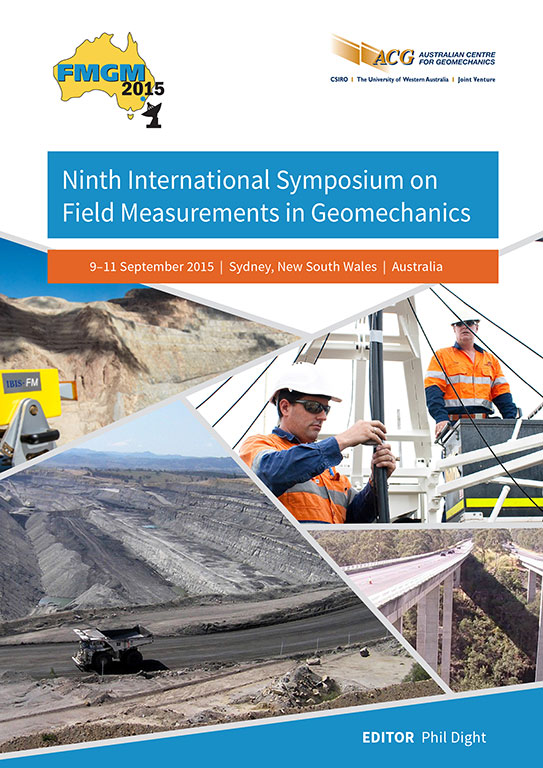Monitoring an unstable road embankment for public safety purposes by Terrestrial SAR Interferometry

|
Authors: Brunetti, A; Mazzanti, P Paper is not available for download Contact Us |
DOI https://doi.org/10.36487/ACG_rep/1508_56_Brunetti
Cite As:
Brunetti, A & Mazzanti, P 2015, 'Monitoring an unstable road embankment for public safety purposes by Terrestrial SAR Interferometry', in PM Dight (ed.), FMGM 2015: Proceedings of the Ninth Symposium on Field Measurements in Geomechanics, Australian Centre for Geomechanics, Perth, pp. 769-780, https://doi.org/10.36487/ACG_rep/1508_56_Brunetti
Abstract:
A road embankment in Northern Italy, made up of reinforced earth, was affected, in 2013, by severe instability problems. Following heavy rainfalls, large cracks appeared on the National and Provincial relevance roads crossing the structure. For public safety, the area was closed causing a serious impact on the local traffic. In this paper is presented an innovative approach based on Terrestrial SAR Interferometric (TInSAR) monitoring for the support to the management of the emergency, the design of stabilisation countermeasures and for the control of the slope stability during the works for the stabilisation of the structure. In a couple of days, the system was installed and collected data allowed to detect a generalised instability affecting the whole embankment with velocity rates ranging between 5 mm/day and 1 mm/day, also in response to heavy rainfalls. Subsequently, a strong deceleration of the phenomenon has been registered. No anomalies have been detected, on the contrary, on the surrounding areas and on the slope upon the embankment, thus suggesting for the instability of the only engineering structure. Following the emergency phase, TInSAR monitoring allowed controlling the stability of the embankment also during the implementation of the stabilisation works for safety and early warning purposes. A progressive mitigation of the instability phenomenon has been registered up to its overall depletion, thus suggesting the efficacy of the performed works.
References:
Antonello, G, Casagli, N, Farina, P, Leva, D, Nico, G, Sieber, AJ & Tarchi, D 2004, ‘Ground-based SAR interferometry for monitoring mass movements’, Landslides, vol. 1, no. 1, pp. 21-28.
Bozzano, F, Cipriani, I, Mazzanti, P & Prestininzi, A 2011, ‘Displacement patterns of a landslide affected by human activities: insights from ground-based InSAR monitoring’, Natural hazards, vol. 59, no. 3, pp. 1377-1396.
Bozzano, F, Cipriani, I, Mazzanti, P & Prestininzi, A 2014, ‘A field experiment for calibrating landslide time-of-failure prediction functions’, International Journal of Rock Mechanics and Mining Sciences, vol. 67, pp. 69-77.
Bozzano, F, Mazzanti, P, Prestininzi, A & Mugnozza, GS 2010, ‘Research and development of advanced technologies for landslide hazard analysis in Italy’, Landslides, vol. 7, no. 3, pp. 381-385.
Clayton, CRI 2001, Managing geotechnical risk: Improving productivity in UK building and construction, Thomas Telford, London.
Del Ventisette, C, Intrieri, E, Luzi, G, Casagli, N, Fanti, R & Leva, D 2011, ‘Using ground based radar interferometry during emergency: the case of the A3 motorway (Calabria Region, Italy) threatened by a landslide’, Natural Hazards and Earth System Sciences, vol. 11, pp. 2483-2495.
European Standard 2004, EN 1997-1 Eurocode 7: Geotechnical Design – Part 1: General rules, European Committee for Standardization (CEN), Brussels.
Gandolfo, L, Brunetti, A, Bozzano, F, Bratus, A, Busnardo, E, Floris, M, Genevois, R, Mazzanti, P & Saporito, F 2015, ‘The Ligosullo (UD, Italy) Landslide, Revisiting of Past Data and Prospects from Monitoring Activities’, Engineering Geology for Society and Territory, vol. 5, pp. 171-175.
Herrera, G, Fernández-Merodo, JA, Mulas, J, Pastor, M, Luzi, G & Monserrat, O 2009, ‘A landslide forecasting model using ground based SAR data: The Portalet case study’, Engineering Geology, vol. 105, no. 3, pp. 220-230.
Jaboyedoff, M, Oppikofer, T, Abellán, A, Derron, MH, Loye, A, Metzger, R & Pedrazzini, A 2012, ‘Use of LIDAR in landslide investigations: a review’, Natural Hazards, vol. 61, no. 1, pp. 5-28.
Lowry, B, Gomez, F, Zhou, W, Mooney, MA, Held, B & Grasmick, J 2013, ‘High resolution displacement monitoring of a slow velocity landslide using ground based radar interferometry’, Engineering Geology, vol. 166, pp. 160-169.
Luzi, G 2010, ‘Ground based SAR interferometry: a novel tool for geoscience’, Geoscience and Remote Sensing, New Achievements, pp. 1–26.
Mazzanti, P 2011, ‘Displacement monitoring by terrestrial SAR interferometry for geotechnical purposes’, Geotechnical Instrumentation News, vol. 66, pp. 25–28.
Mazzanti, P 2012, ‘Remote monitoring of deformation. An overview of the seven methods described in previous GINs’, Geotechnical Instrumentation News, vol. 72, pp. 24–29.
Mazzanti, P, Bozzano, F, Cipriani, I & Prestininzi, A 2014, ‘New insights into the temporal prediction of landslides by a terrestrial SAR interferometry monitoring case study’, Landslides, vol. 12, no. 1, pp. 55-68.
Mazzanti, P, Brunetti, A & Bretschneider, A 2015, ‘A new approach based on terrestrial remote-sensing techniques for rock fall hazard assessment’, in M Scaioni (ed.), Modern Technologies for Landslide Monitoring and Prediction, Springer Berlin Heidelberg, Heidelberg, pp. 69-87.
Nicholson, D, Tse, CM & Penny, C 1999, The observational method in ground engineering: principles and applications, Construction Industry Research and Information Association, London, 214 p.
Noferini, L, Pieraccini, M, Mecatti, D, Macaluso, G, Luzi, G & Atzeni, C 2006, ‘Long term landslide monitoring by ground‐based synthetic aperture radar interferometer’, International Journal of Remote Sensing, vol. 27, no. 10, pp. 1893-1905.
Peck, RB 1969, ‘Advantages and limitations of the observational method in applied soil mechanics’, Geotechnique, vol. 19, no. 2, pp. 171-187.
Tarchi, D, Casagli, N, Fanti, R, Leva, DD, Luzi, G, Pasuto, A, Pieraccini, M & Silvano, S 2003, ‘Landslide monitoring by using
ground-based SAR interferometry: an example of application to the Tessina landslide in Italy’, Engineering Geology, vol. 68, no. 1, pp. 15-30.
© Copyright 2025, Australian Centre for Geomechanics (ACG), The University of Western Australia. All rights reserved.
View copyright/legal information
Please direct any queries or error reports to repository-acg@uwa.edu.au
View copyright/legal information
Please direct any queries or error reports to repository-acg@uwa.edu.au